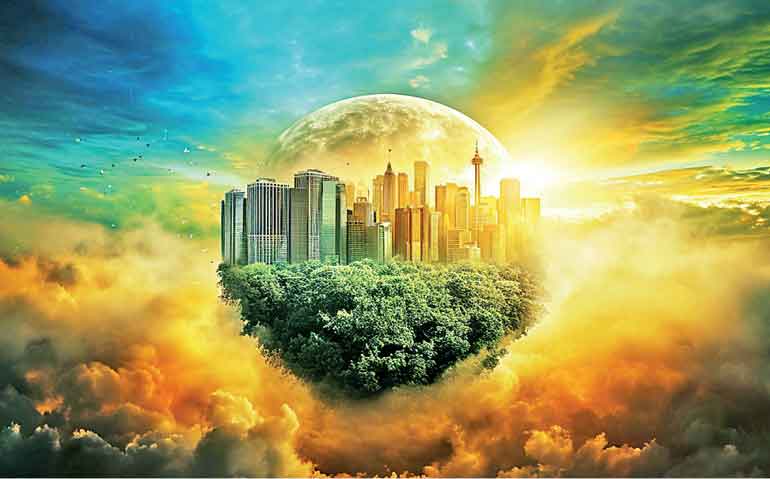Monday Apr 21, 2025
Monday Apr 21, 2025
Saturday, 20 January 2024 00:09 - - {{hitsCtrl.values.hits}}

Art and fiction can play an important role in enhancing awareness and understanding of the climate crisis as well as showcasing ground realities, particularly from the Global South
 The climate crisis is a key challenge for countries and communities across the globe, especially, for climate-vulnerable developing countries such as Sri Lanka. As climate change affects the whole of society, solutions to it also need to consider and involve every sector and level, from agriculture to energy and from local to global.
The climate crisis is a key challenge for countries and communities across the globe, especially, for climate-vulnerable developing countries such as Sri Lanka. As climate change affects the whole of society, solutions to it also need to consider and involve every sector and level, from agriculture to energy and from local to global.
In order to build the capacities and mobilise resources for effective climate change mitigation, adaptation, and addressing loss and damage, it is crucial to invest in key enablers such as education, training, and awareness creation. Similarly, art and fiction can play an important role in enhancing awareness and understanding of the climate crisis as well as showcasing ground realities and potential solutions.
Documentary and realist fiction
Art and fiction, for example, short stories, novels, dramas, TV series, movies, music, photographs, or artworks, can document and convey climate change in ways that go beyond data and research findings. Fiction offers a unique avenue to explore the emotional and psychological dimensions of climate change and translate statistics into tangible human experiences. Through the lens of fiction, readers can explore the personal and social consequences of the climate crisis that brings to life the realities that people already face or would face in the future.
What does it mean to be forced to migrate due to persistent drought? How do people live through a storm or flood? In what ways do sea levels rise and loss of cultural heritage affect coastal communities? Fictional narratives and depictions can attempt to answer these questions and flesh out what terms like “climate migration,”“extreme weather event,”“loss and damage,” or “adaptation” really mean on the ground.
Especially, when it comes to countries of the Global South, where vulnerable communities often find themselves at the frontlines of climate change, there is lack of experiences, realities, and perspectives that reach a global audience. Realist or naturalist fiction on the climate crisis can close this gap by showcasing how climate impacts affect human lives and livelihoods, as well as stories of resilience and adaptation that are borne from the crucible of the climate crisis.
By focusing on individual stories and characters, art and fiction can foster a deeper emotional connection to climate-related issues. The audience can become invested in the fates of characters who navigate the challenges of a changing climate and its many short- and long-term implications within a concrete local context, personalising the often distant and impersonal nature of climate science while offering a glimpse of coping strategies, adaptive actions, and resilience-building.
The climate crisis as a backdrop
Another way to address climate change in art and fiction is by relegating it to the background instead of turning it into the main focus. For example, environmental degradation, climatic changes, or extreme weather events can be present and influence the setting, character motivations, and plot development in an organic way without taking away from other key elements. In paintings and installations, this could be subtle alterations to landscapes or materials that invite reflection on the climate crisis; in music, it could be lyrics or the setting of a dance video.
The power of climate change as a background element lies in its integration into the fabric of everyday life and its representation as a reality that influences all aspects of human existence. Furthermore, fiction can challenge prevailing narratives about climate change, adaptation, and loss and damage. By using the climate crisis as a backdrop or including it as a natural part of the setting, it can contribute to normalise the discourse and offer alternative viewpoints, expanding awareness of the many facets of climate change at the local, national, and global level.
Imagining other worlds and futures
Fiction and art can go beyond the documentary and realist mode to imagine rich, immersive worlds that illustrate the long-term implications of climate change or represent climate anxiety, hope, fear, and exposure in more abstract ways. This can be in the form of future scenarios and thought experiments, ranging from subtle shifts in everyday life to dramatic transformations of landscapes and societies; or in the form of non-realist fiction, be it science fiction, horror, fantasy, ghost stories, magic realism, mystery, or postmodern literature.
As we enter 2024, climate change continues to be a defining challenge of our time. Art and fiction can harness the power of storytelling to convey the present, imagine the future, and create an emotional resonance. They offer an almost unlimited space for thematising the climate crisis and turning it not only into a subject of discussion but something that is experienceable and relatable for a broad audience while being based on a concrete local context. Through this, they have the potential to entertain as well as educate, inform, expand existing narratives, highlight diverse perspectives, and inspire action and change.
(The writer is a Director: Research and Knowledge Management at SLYCAN Trust, a non-profit think tank based in Sri Lanka. His work focuses on climate change, adaptation, resilience, ecosystem conservation, just transition, human mobility, and a range of related issues. He holds a Master’s degree in Education from the University of Cologne, Germany and is a regular contributor to several international and local media outlets.)
Discover Kapruka, the leading online shopping platform in Sri Lanka, where you can conveniently send Gifts and Flowers to your loved ones for any event including Valentine ’s Day. Explore a wide range of popular Shopping Categories on Kapruka, including Toys, Groceries, Electronics, Birthday Cakes, Fruits, Chocolates, Flower Bouquets, Clothing, Watches, Lingerie, Gift Sets and Jewellery. Also if you’re interested in selling with Kapruka, Partner Central by Kapruka is the best solution to start with. Moreover, through Kapruka Global Shop, you can also enjoy the convenience of purchasing products from renowned platforms like Amazon and eBay and have them delivered to Sri Lanka.
Discover Kapruka, the leading online shopping platform in Sri Lanka, where you can conveniently send Gifts and Flowers to your loved ones for any event including Valentine ’s Day. Explore a wide range of popular Shopping Categories on Kapruka, including Toys, Groceries, Electronics, Birthday Cakes, Fruits, Chocolates, Flower Bouquets, Clothing, Watches, Lingerie, Gift Sets and Jewellery. Also if you’re interested in selling with Kapruka, Partner Central by Kapruka is the best solution to start with. Moreover, through Kapruka Global Shop, you can also enjoy the convenience of purchasing products from renowned platforms like Amazon and eBay and have them delivered to Sri Lanka.